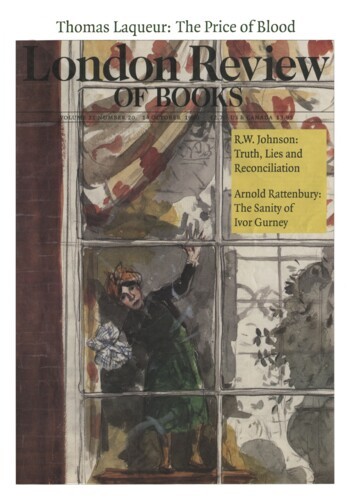The Armley Hippo
Brickfield workmen turned up a quern and bones in clay –
gigantic, not Christian, a prodigious thigh and forearm
aroused their curiosity ... Eighteen fifty two, Armley,
and a bewhiskered Mr Denny, having stimulated the men
to increased care and search, with the generous promise
of small rewards of cash, amassed a big collection of bones,
before seeking the excited examination and expert advice
of a Mr Pridgin Teale. Teale pronounced them bits of skeletons
of the Great Northern Hippopotamus, with some oddments of
elephant and ox or auroch, thrown in for good measure.
One hundred thousand years ago they lived in the Armley area
– Ipswichian Interglacial, encoded in femur and tooth.
Set upon in Armley Town Street, by two half-cut contemporaries
–sapiens, Elizabethan – a victim can claim a thousand
pounds for a broken rib or nose. And as much as ten thousand
for permanent, sight-impairing damage to the eyes.
Arcade
The shelf of shunted pennies is still stacked just not teetering
in the foursquare amusement arcade’s perennial cliffhanger.
Roll one in edgewise and take a chance ... This building’s a flat-
roofed concrete block, albeit a block festooned with mauve neon –
it hits you after miles of winding coast road and perches there –
like the gateway to a non-existent pier – backed by flats
of sand and tidal mud at sudden dusk. Somewhere out towards
vanishing point is a stalled bluish-black rim of sea.
(On the beach at Madras: a refusal to pay and enter in, to a sack-
curtained sideshow to view: a mermaid, a misbirth, a maimed one.)
Lit
Think of one lit thing and you’ll think of another.
A lit glass tank, say, of water and fish –
its electric greens and blues
seen through curtains made gauze
by a darkened room passed on a dirty night.
The out-of-season seaside aquarium,
with creatures like those Nemo saw phosphoresce,
undulating in the ruins of Atlantis
through the iron portholes of the Nautilus.
An angler-fish in a hand-coloured illustration.
What tropical fishkeeping might ‘mean’,
here in the wintry inner city with a plastic carrier
flying up and hovering half as high as the moon.
The dashboard with its full set on
in motorway fog – including the cobalt one
with black pictogram showing ‘full-beam’,
in a square like the lit ones with sliding caps
you close in arcade bingo when your number is up.
The charged decals and digits on a travel alarm,
bleached turquoise at four in the morning,
the LYRIC (now a warehouse) outside in red neon.
Lit ... lit ... illuminated. The pulsing off and on
of the scarlet message counter on the answerphone,
stacked messages prolonging for each caller
the waiting tone: what sounded like
a Verdi aria played on a Bontempi organ.
The umber panel of an attic-stored valve radio,
its brushed aluminium and the milliseconds’
delay between turning the tooled switch
and looking into a scratched oblong of warm light.
And the heartstopped recording cardiogram
you pictured on the night the fire no longer
kindled against the darkness, and you caught
in the headlamps a loping stoat’s eyes –
caught it sipping the brains of a knocked-down hare,
a bloody patch of wind-ruffled fur –
reciting ‘stopping distances’ on a blacked-out moor.
Think of one lit thing and you’ll think of another.
Montale at War
After Montale
The desire to grip old familiar hands
to be reflected in once-known eyes
beneath the streaming of a frozen blue
that the belling of the shrapnel shivers.
Send Letters To:
The Editor
London Review of Books,
28 Little Russell Street
London, WC1A 2HN
letters@lrb.co.uk
Please include name, address, and a telephone number.

